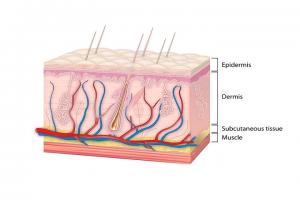THE SKIN: BASIC KNOWLEDGE OF HUMAN SKIN

The covering, or integument, of the body’s surface, that both provides protection and receives sensory stimuli from the external environment.
ï¬The skin and its appendages (nails, hair and certain glands) form the largest organ in the human body.
ï¬Â total area of about 20 square feet.
ï¬The skin comprises 15% of the total adult body weight.
It serves as a protective shield against heat, light, injury, and infection. The skin also:
ï¶Regulates body temperature
ï¶Stores water and fat
ï¶Is a sensory organ
ï¶Prevents water loss
ï¶Prevents entry of bacteria
ï¶Acts as a barrier between the organism and its environment
ï¶Helps to make vitamin D when exposed to the sun
our skin takes on different thicknesses, colours, and textures all over our bodies. For example, the head contains more hair follicles than anywhere else. But the soles of feet have none. In addition, the soles of the feet and the palms of hands are much thicker than the skin on other areas of the body.
It is made up of three layers
1. the epidermis
2. dermis
3. Hypodermis
The epidermis, the outermost layer of skin, provides a waterproof barrier and creates our skin tone.
The deeper subcutaneous tissue (hypodermis) is made of fat and connective tissue.
The dermis, beneath the epidermis, contains tough connective tissue, hair follicles, and sweat glands.
The skin’s color is created by special cells called melanocytes, which produce the pigment melanin. Melanocytes are located in the epidermis.
Stay tuned.